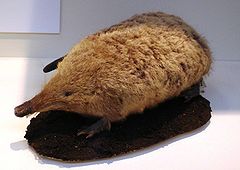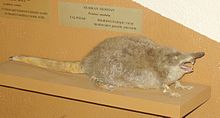- Russian Desman
-
Russian Desman[1] Conservation status Scientific classification Kingdom: Animalia Phylum: Chordata Class: Mammalia Order: Soricomorpha Family: Talpidae Subfamily: Talpinae Tribe: Desmanini Genus: Desmana
Güldenstädt, 1777Species: D. moschata Binomial name Desmana moschata
(Linnaeus, 1758)
Russian Desman range The Russian Desman (Desmana moschata) (Russian: выхухоль) is a small semi-aquatic mammal that inhabits the Volga, Don and Ural River basins in Russia, Ukraine and Kazakhstan. It constructs burrows into the banks of ponds and slow-moving streams, but prefers small, overgrown ponds with abundance of insects, crayfish and amphibians. The Russian Desman often lives in small (usually non-kin related) groups of 2 to 5 animals and appears to have a complex (but largely unstudied) communication and social system.
The Russian Desman is the only species of the genus Desmana. Despite its outward similarity to muskrats (a rodent), the Russian Desman is actually part of the mole family Talpidae in the order Soricomorpha. Like other moles, it is functionally blind and obtains much of its sensory input from the touch-sensitive Eimer's organs at the end of its long, bi-lobed snout. However, the hind feet are webbed and the tail is laterally flattened —specializations for its aquatic habitat. The body is 18 to 21 centimetres (7.1 to 8.3 in) long while the tail is 17 to 20 centimetres (6.7 to 7.9 in) in length. Easily the largest species of mole, it weighs 400 to 520 grams (14 to 18 oz).
Decidedly rich and thick in nature, desman fur used to be highly sought after by the fur trade. Consequently, the Russian Desman is now a protected species under Russian law. Unfortunately, due to loss of habitat (farming), water pollution, illegal fishing nets, and the introduction of non-native species (e.g. muskrat), population levels continue to decline. In the mid-1970s, there were an estimated 70,000 desmans in the wild; by 2004 the figure was only 35,000. Fortunately, at least in some Russian regions, the number of desmans appears to be increasing.
References
- ^ Hutterer, Rainer (16 November 2005). Wilson, Don E., and Reeder, DeeAnn M.. ed. Mammal Species of the World (3rd ed.). Baltimore: Johns Hopkins University Press, 2 vols. (2142 pp.). pp. 303. ISBN 978-0-8018-8221-0. OCLC 62265494. http://www.bucknell.edu/msw3.
- ^ Insectivore Specialist Group (1996). Desmana moschata. 2006. IUCN Red List of Threatened Species. IUCN 2006. www.iucnredlist.org. Retrieved on 2006-05-11. Listed as Vulnerable (VU B1+2c v2.3)
External links
- ARKive - images and movies of the Russian desman (Desmana moschata)
- June 9, 2006, BBC, Campaign to save the Russian desman



